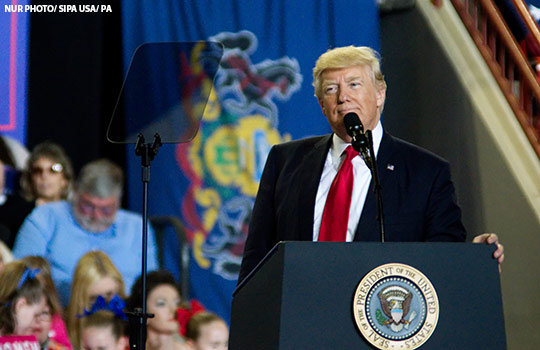 Donald Trump continues to threaten to pull the trigger and scrap the Affordable Care Act (ACA). The day after his failed attempt to repeal and replace the ACA on 24 March, he tweeted, “Obamacare will explode . . . Do not worry.” Then, in mid-April, one way this might happen was put forward: by cutting costs sharing reduction (CSR) payments to seven million lower income ACA enrollees. These subsidy payments reduce out of pocket costs for lower income families by reducing or eliminating deductibles.
Donald Trump continues to threaten to pull the trigger and scrap the Affordable Care Act (ACA). The day after his failed attempt to repeal and replace the ACA on 24 March, he tweeted, “Obamacare will explode . . . Do not worry.” Then, in mid-April, one way this might happen was put forward: by cutting costs sharing reduction (CSR) payments to seven million lower income ACA enrollees. These subsidy payments reduce out of pocket costs for lower income families by reducing or eliminating deductibles.
More recently, over the past two weeks the administration has sought to appeal to hardline conservatives: firstly, by giving more power to individual states on how move forward on reform, and secondly, by removing safeguards for people with pre-existing conditions. Both proposed changes have been met with fierce resistance this week by moderate Republicans. But with the recent promise to inject an additional $8bn spending into Trump’s reform package, the outcome hangs by a thread.
Dismantling Obamacare is part of Trump’s goal to “Make America Great Again.” Yet in the health sector, America was never “great”—at least as measured by the criteria of equity and efficiency.
Eight years ago (that is, two presidential terms ago) the groundbreaking study The Measure of America was released. Modeled on the United Nations Development Program’s Human Development Report, it asked a fundamental populist question, “How are people in the United States doing?” It did not ask “how are we doing in terms of economic growth, trade, and investment?”—the question normally asked by the establishment to measure progress. It introduced the American Human Development Index: a single measure of wellbeing for all Americans based on life expectancy, access to knowledge, and income, which was disaggregated by geographical location (by state and by congressional district), race, ethnic group, and sex.
The index data provided new detail on the US healthcare system, showing that it was a poor performer compared to its peers, spending on average three times more on healthcare than other industrialized nations while leaving tens of millions of people without adequate health insurance. At the heart of this failure were inequalities. When Barack Obama assumed office in January 2009, he was confronted by two striking sets of inequalities: those defined by race and by place of residence.
For example, African-Americans with vascular disease or diabetes were four times more likely to have a leg amputated than white people. Data showed that infant mortality rates among African-Americans were more than two times, and in some southern states three times, higher than the national average. Nine states shared the worst levels of health and human development and these were in the south, where African-American populations are 70% larger than the national average.
Set against this background and the social architecture that supported these large inequalities, Obama sought to make good on his commitment to create a level playing field for all Americans, especially in healthcare. Yet although he began his presidency with the “promise of change, unity, and bipartisanship” (and indeed, 80% of the public described themselves as optimistic about the new president), he soon hit a brick wall with his proposed healthcare bill. According to a recent documentary series The Divided States of America, as he embarked upon health reform he “quickly collided with political realities, including unified Republican opposition to his agenda and racially charged resistance.”
After a year of intense struggle, Obamacare passed the House of Representatives on 21 March 2010 by a vote of 219 to 212, but without a single Republican vote. A general theme of the PBS report was that Obamacare “contributed to years of polarization and a wave of anti-establishment sentiment that helped fuel Trump’s road to victory” (see transcripts online). Drawing from dozens of experts and Congressional leaders, the documentary reported that “Obamacare came to symbolize the divisions in America.” It claimed that “what happened after it was passed, and because of the way it was passed, it became the symbol of the divide, and the reality of it in many ways.” This portrayal of Obamacare as a bill forced through amid discord was a view that Trump successfully exploited on his campaign trail.
The documentary concluded that the future of Obamacare is uncertain since it is unclear “whether or when the country might finally accept what he has done” (by passing the ACA). Trump’s efforts to repeal and replace Obamacare are also based on the notion that most Americans do not accept Obamacare. Yet these assessments do not seem consistent with the evidence, or at least are no longer consistent with the latest evidence.
For example, a Kaiser tracking poll done in early April and then a Washington Post-ABC News poll done at the end of April contradict this conclusion. Kaiser showed that 64% of the American public thought it was a good thing that Trump’s American Health Care Act failed to pass. Seventy five per cent of the public think that Trump and his administration “should do what they can to make the current law work.” The Washington-Post-ABC News poll found that 61% of the public thought Trump should keep and improve Obamacare. Other noteworthy findings are that 70% of the public (including a majority of Republicans) want a nationwide mandate for pre-existing conditions rather than Trump’s notion of leaving it up to states to decide—as was under consideration last week and this week.
One explanation for the mismatch between the PBS assessment (and indeed, Trump’s misreading of the public) and the results of these two polls is that the tone and quality of leadership and decision making of the past 100 days may have disenchanted many Americans. The executive orders aimed at deregulation—especially of the finance and banking sectors—and the proposed enormous tax cuts appear to benefit the privileged 1%. Consistent with this is a Kaiser poll finding that the percentage of Americans who believed that Trump could deliver better and cheaper healthcare dropped from 47% before the election to 37% three months later.
Behind these poll results may also be a growing perception that Obamacare is actually a populist law and that Trumpcare is anti-populist. The fact that this was not taken on board before the election perhaps confirms the adage that left wing economics can never satisfy right wing populism.
Trump may not be returning America back to greatness, but he is certainly committed to returning it to the direction from whence it came—a time of greater inequality and variation in access to healthcare.
Dr Chris Simms teaches at Dalhousie University, School of Health Administration, Halifax, Canada; he spent many years living and working in Africa’s health sector.
Competing interests: None declared.
